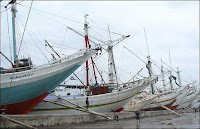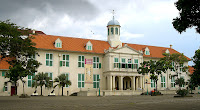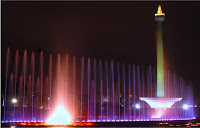The Portuguese was the first European to come to Jakarta. In the 16th century, Surawisesa, the king of Sunda request assistance Portuguese in Malacca to establish a fort at Sunda Kelapa as protection from possible attacks Cirebon that will secede from the Kingdom of Sunda. Efforts Surawisesa assistance request to the Portuguese in Malacca is enshrined by the Sundanese in rhyme story Seloka Mundinglaya Dikusumah, where Surawisesa diselokakan with his title the name of Mundinglaya. But before the establishment of the fort are taken, Cirebon Demak assisted directly attacked the port. Sundanese people call this incident a tragedy, because the attack membungihanguskan port city and killed many people there, including Syahbandar port of Sunda.Determination of the anniversary of Jakarta on 22 June by Sudiro, the mayor of Jakarta, in 1956 is based on the tragedy of the occupation of the port of Sunda Kalapa by Fatahillah in 1527.Fatahillah change the name of the city into Jayakarta, meaning "city of victory". Furthermore, Sunan Gunung Jati of the Sultanate of Cirebon, the government handed over to his son in the White Rose of Sultan Maulana Hasanuddin who became sultan of the Sultanate of Banten.
The Dutch came to the White Rose around the end of the 16th century, after a stopover in Banten in 1596. Abat White Rose at the beginning of the 17th White Rose was ruled by Prince, one of the relatives of the Sultanate of Banten. In 1619, the VOC was led by Jan Pieterszoon Coen's troops occupied the White Rose after defeating the Sultanate of Banten and then changed its name to Batavia. During the Dutch colonization, Batavia developed into a large and important city. (See Batavia). For urban development, the Dutch import many slaves as workers. Most of them come from Bali, Sulawesi, Maluku, China, and the Malabar coast, India. Some argue that these are to then form a community known as the Batavian tribe. It was widely Batavia only cover the area currently known as Old Town in North Jakarta. Before the arrival of slaves, the existing Sundanese people who live in areas such as community Jatinegara The White Rose. While the tribes of ethnic immigrants, in the days of Dutch kolinialisme, forming communities of each region. So in Jakarta there are territories of the former community like Chinatown, Pekojan, Kampung Melayu, Kampung Bandan, Kampung Ambon, Bali Village, and Manggarai.
On October 9, 1740, there were riots in Batavia with the murder of 5,000 Chinese. With these riots, many Chinese people who ran out of town and take the fight against the Dutch. [11] With the completion Koningsplein (Gambir) in 1818, Batavia was developed to the south. In 1920, the Dutch built the city park Menteng, and this region into a new place for the top brass to replace Molenvliet in northern Holland. At the beginning of the 20th century, north of Batavia, Koningspein, and Mester Cornelis (Jatinegara) have been integrated into a city.
Colonization by Japan began in 1942 and changed the name of Batavia to Jakarta to attract the hearts of the people in World War II. The city is also the site of the Proclamation of Indonesian Independence on August 17, 1945 and occupied by the Dutch until the recognition of sovereignty in 1949.
Since the declared as the capital city, Jakarta residents jumped very rapidly due to manpower needs of almost all central government in Jakarta. Within 5 years the population doubled over two. Various bags of new middle-class neighborhoods and then expand, like Kebayoran Baru, Cempaka Putih, Rawamangun, and Pejompongan. The centers are also many settlements built independently by various ministries and state institutions such as the Public Corporation Housing.
This population growth rate had been tried were pressured by the governor Ali Sadikin in the early 1970s by stating Jakarta as a "closed city" for immigrants. This policy can not walk and forgotten in times of leadership next governor. Until now, Jakarta still have to wrestle with the problems that occur due to overcrowding, such as flooding, traffic jams, and lack of adequate public transportation.
Culture Jakarta is a mestizo culture, or a mixture of diverse ethnic cultures. Since the days of the Netherlands, Jakarta is the capital city of Indonesia, which attracted immigrants from within and outside the archipelago. The tribes who inhabit Jakarta, among others, Javanese, Sundanese, Minangkabau, Batak, and the Bugis. Apart from population Nusantara, Jakarta culture also absorb a lot of foreign cultures, such as Arab culture, Chinese, Indian, and Portuguese.
In order to create the city of Jakarta as a shopping destination, the government held the program "Enjoy Jakarta". The program is one of them held in shopping centers located in Jakarta. To realize Jakarta as an excellent shopping destination, the government is currently developing Casablanca-Satrio axis as the axis of tourist spending. In this axis, in addition to existing shopping centers Ambassador and ITC Kuningan Mall, a shopping center will also present Ciputra World, Brass City, and City of Casablanca.Epicentrum that is not far from the axis, will be integrated into the shaft-Satrio Casablanca shopping tour.

Interesting Places in Jakarta:
Taman Mini Indonesia Indah, Thousand Islands, the National Monument (Monas), National Museum, Old City of Jakarta, Sunda Kelapa Harbor, Ancol Bay City




Hi,
ReplyDeleteI am writing a blog post about Jakarta and I found some nice pictures on your site. Can I use them, citing your site as the author? My blog is http://da-scoprire.678voli.it/ (in Italian language) and I am writing about various cities, mostly in Europe.
Thanks,
Debora